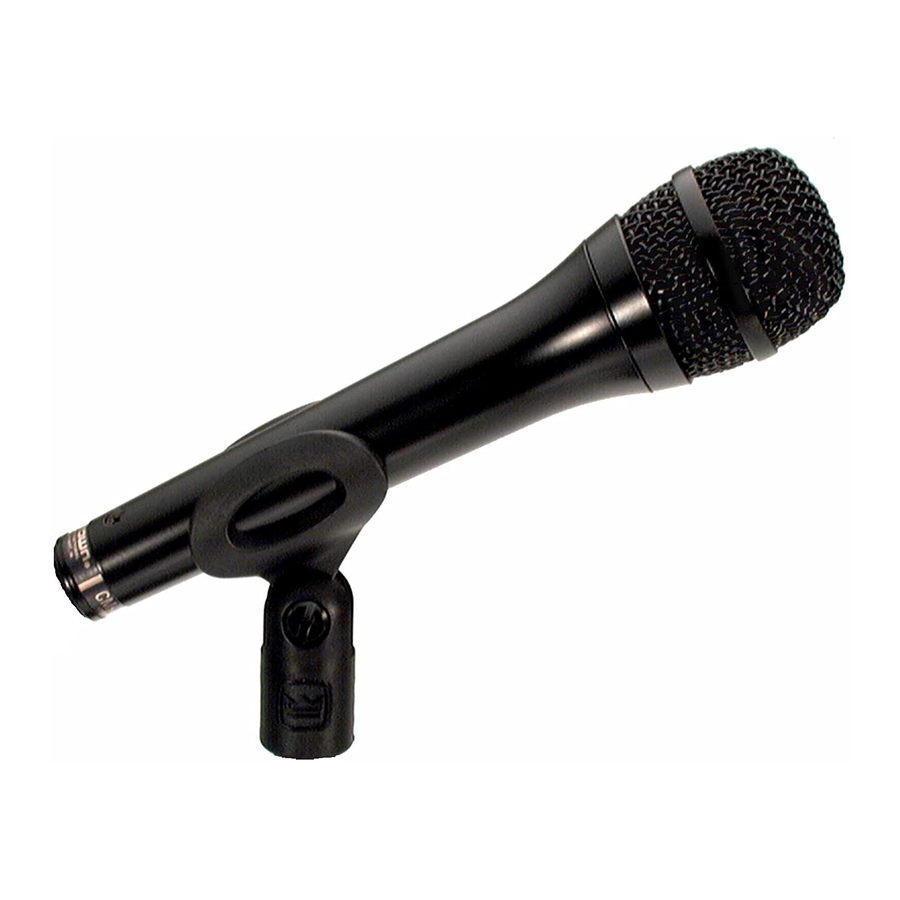
Crown CM-200A Application Manual
Microphones for video
Hide thumbs
Also See for CM-200A:
- Application manual (10 pages) ,
- Datasheet (2 pages) ,
- Application manual (7 pages)
Advertisement
© 2000 Crown International, All rights reserved.
PZM
®
, PCC
®
, SASS
®
and DIFFEROID
®
Crown International, Inc. Also exported as Amcron
131374-1
6/00
, are registered trademarks of
®
Crown International, Inc
P.O. Box 1000, Elkhart, Indiana 46515-1000
(219) 294-8200 Fax (219) 294-8329
www.crownaudio.com
Advertisement
Table of Contents

Summary of Contents for Crown CM-200A
- Page 1 © 2000 Crown International, All rights reserved. ® , PCC ® , SASS ® and DIFFEROID ® , are registered trademarks of ® Crown International, Inc. Also exported as Amcron 131374-1 6/00 Crown International, Inc P.O. Box 1000, Elkhart, Indiana 46515-1000 (219) 294-8200 Fax (219) 294-8329 www.crownaudio.com...
-
Page 2: Transducer Types
MICROPHONE TECHNIQUES FOR VIDEO No matter what your video application — sports, news, corporate training — the soundtrack quality depends on the microphones you choose and where you place them. This booklet covers microphone techniques to help you achieve better audio for your video productions. -
Page 3: Polar Patterns
Currently, all Crown microphones are the electret condenser type — a design of proven reliability and studio quality. POLAR PATTERNS Microphones also differ in the way they respond to sounds coming from different directions. The sen- sitivity of a microphone might be different for sounds arriving from different angles. -
Page 4: Frequency Response
Fig. 6 – Frequency response. FORMS OF MICROPHONES Microphones come in many shapes that have dif- ferent functions: Fig. 7 – Handheld microphone. Handheld (Figure 7). Used in the hand or on a mic stand. An example is the Crown CM-200A cardioid condenser microphone. - Page 5 Fig. 8 – Lavalier microphone. Lavalier (Figure 8). A miniature microphone which you clip onto the clothing of the person speaking. Two examples are the Crown GLM-100 (omni) and GLM-200 (hypercardioid). Fig. 9 – Boundary microphone. Boundary (Figure 9). Boundary microphones are meant to be used on large surfaces such as stage floors, piano lids, hard-surfaced panels, or walls.
- Page 6 If there were a spacing, this would create a delay between left and right signals which can cause phase cancellations in mono. The Crown SASS stereo microphone, explained next, has spaced mic capsules but is still mono-compatible because of its special design.
-
Page 7: Electrical Characteristics
•Place the mic closer to the sound source. •Use an automatic (gated) mixer. This device turns off all microphones not in use, providing a clearer, less muddy sound. •Pick up each electric instrument with a direct box or cable. - Page 8 To clearly pick up sound at a distance: •Use a microphone with low self-noise (say, less than 22 dB SPL), such as the Crown PCC-160, PCC- 170, CM-200A, or any PZM). •Boost the presence range on your mixer’s EQ (around 5 kHz).
- Page 9 •Use an omnidirectional microphone, such as a GLM-100 or any PZM. •Use a directional microphone with low sensitivity to handling noise and thump, such as the CM-200A, CM-310A, PCC-160, PCC-170, or PCC-200. •Use a directional microphone with an internal shock mount.
- Page 10 The Crown SASS stereo microphone is also mono com- patible. Fig. 21 – A coincident pair.
- Page 11 In these examples, we’ll assume it’s all right to see the microphone on-camera. •Clip a lavalier mic (such as the Crown GLM-100) onto the announcer’s shirt about 8 inches below the chin (Figure 24). Aim the front of the micro- phone at the mouth.
- Page 12 EQ until the sound is natural. Go wireless if the ac- tor moves around a lot. The Crown GLM-100-E is an omni lavalier without electronics, which you plug into a wireless transmitter.
- Page 13 these soundtracks won Emmys. The SASS was used in the Indy 500 to pick up the audience and race cars in stereo. Interviews For people seated at a table, try a PZM-6D in the center of the table (Figure 27). Fig.
- Page 14 Try hanging several cardioid mics over the audience. To record audience reaction, try a single stereo mic such as the Crown SASS-PMK11. Or try a PZM on a 2-foot-square plexiglass panel. Basketball A typical setup employs headset mics for the an- nouncers mixed with a another mic aiming at the crowd.To pick up the floor action, use a shotgun...
- Page 15 Security and surveillance A microphone designed for this purpose is the Crown PZM-11. It can be mounted in the ceiling or wall in a standard electrical outlet box. The PZM-11 is designed to look like a light switch so as not to draw attention.










Need help?
Do you have a question about the CM-200A and is the answer not in the manual?
Questions and answers